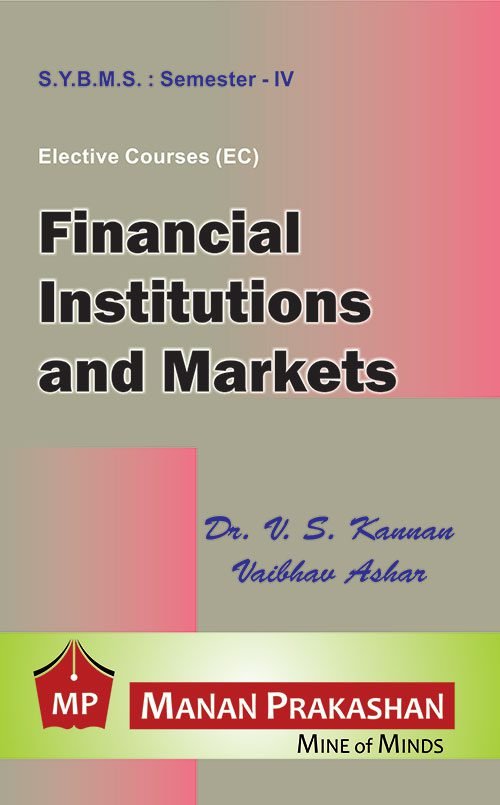Financial Institutions and Markets SYBMS Semester IV
Elective Course
Content:
1. Financial System in India (16 Lec.)
l Financial System Theoretical Settings – Meaning, Importance, Functions of financial system, Indian financial system from financial neutrality to financial activism and from financial volatility to financial stability. Role of government in Financial development, Phases of Indian financial system since independence (State Domination – 1947-1990, Financial sector reforms 1991 till Financial sector Legislative Reforms Commission 2013) (Only an Overview) Monitoring Framework for financial Conglomerates
l Structure of Indian Financial System – Financial Institutions (Banking & Non-Banking ), Financial Markets (Organized and Unorganized), Financial Assets/Instruments, Financial Services (Fund based & Free Based) – (In details)
l Microfinance – Conceptual Framework – Origin, Definitions, Advantages, Barriers, Microfinance Models in India
1. Financial System in India (16 Lec.)
l Financial System Theoretical Settings – Meaning, Importance, Functions of financial system, Indian financial system from financial neutrality to financial activism and from financial volatility to financial stability. Role of government in Financial development, Phases of Indian financial system since independence (State Domination – 1947-1990, Financial sector reforms 1991 till Financial sector Legislative Reforms Commission 2013) (Only an Overview) Monitoring Framework for financial Conglomerates
l Structure of Indian Financial System – Financial Institutions (Banking & Non-Banking ), Financial Markets (Organized and Unorganized), Financial Assets/Instruments, Financial Services (Fund based & Free Based) – (In details)
l Microfinance – Conceptual Framework – Origin, Definitions, Advantages, Barriers, Microfinance Models in India
2. Financial Regulators & Institutions in India (detail discussion on their role and functions) (16 Lec.)
l Financial Regulators – Ministry of Finance (Dept. of DEA, Expenditure, Revenue, financial services and disinvestment) RBI – Changing Role of RBI in the financial sector, global crisis and RBI, Ministry of Corporate Affairs, SEBI, Pension Fund Regulatory and Development Authority, IRDA.
l Financial Institutions – Role, Classification, Role of Commercial Banks, IFCI, IDBI, Industrial Credit and Investment Corporation of India, SFC, Investment institutions in India ( LIC, GIC) NBFC services provided by NBFC.
l Specialized Financial Institutions – EXIM, NABARD, SIDBI, NHB, SIDC, SME Rating agency of India Ltd, IIFCL, IWRFC (Their role, functions and area of concerns)
l Financial Regulators – Ministry of Finance (Dept. of DEA, Expenditure, Revenue, financial services and disinvestment) RBI – Changing Role of RBI in the financial sector, global crisis and RBI, Ministry of Corporate Affairs, SEBI, Pension Fund Regulatory and Development Authority, IRDA.
l Financial Institutions – Role, Classification, Role of Commercial Banks, IFCI, IDBI, Industrial Credit and Investment Corporation of India, SFC, Investment institutions in India ( LIC, GIC) NBFC services provided by NBFC.
l Specialized Financial Institutions – EXIM, NABARD, SIDBI, NHB, SIDC, SME Rating agency of India Ltd, IIFCL, IWRFC (Their role, functions and area of concerns)
3. Financial Markets (In Details) (16 Lec.)
l Indian Money Market – Meaning, Features, Functions, Importance, Defects, Participants, Components ( Organized and Unorganized) ( in details) and Reforms
l Indian Capital Market – Meaning, Features, Functions, Importance, Participants, Instruments, Reforms in Primary and Secondary Market, Stock Indices, NSE, BSE, ADR and GDR
l Introduction of Commodity and Derivative Markets
l Insurance and Mutual Funds – An introduction
l Indian Money Market – Meaning, Features, Functions, Importance, Defects, Participants, Components ( Organized and Unorganized) ( in details) and Reforms
l Indian Capital Market – Meaning, Features, Functions, Importance, Participants, Instruments, Reforms in Primary and Secondary Market, Stock Indices, NSE, BSE, ADR and GDR
l Introduction of Commodity and Derivative Markets
l Insurance and Mutual Funds – An introduction
4. Managing Financial Systems Design (12 Lec.)
l Financial System Design – Meaning, Stakeholder Lender Conflict, Manager Stock holder conflict, Conflict Resolution and Financial System Design, Bank oriented systems and Market oriented systems its advantages and drawbacks, Dimensions of well-functioning financial systems
l At Global Level – Financial system designs of Developed countries (Japan, Germany, UK and USA) (Brief Summary)
l Case Studies relating to disinvestment policies of PSU in India, Global crises, and failures in market systems around world
l Financial System Design – Meaning, Stakeholder Lender Conflict, Manager Stock holder conflict, Conflict Resolution and Financial System Design, Bank oriented systems and Market oriented systems its advantages and drawbacks, Dimensions of well-functioning financial systems
l At Global Level – Financial system designs of Developed countries (Japan, Germany, UK and USA) (Brief Summary)
l Case Studies relating to disinvestment policies of PSU in India, Global crises, and failures in market systems around world
Additional Information
| BOARD | Mumbai University |
|---|---|
| ISBN-13 | 978-93-89293-53-1 |
| AUTHOR | Dr. V. S. Kannan, Vaibhav Ashar |
| PUBLISHER | Manan Prakashan |
| ED | All |
| PAGES | 288 |
| SUBJECT | Financial Institutions and Markets SYBMS Semester IV |
| LANGUAGE | English |


Reviews
There are no reviews yet.